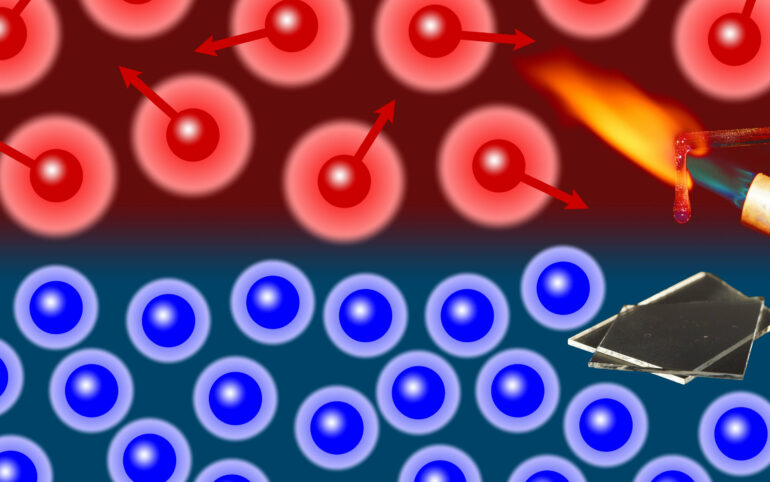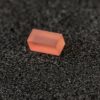In a recently published article in the journal Nature Physics, a team of researchers with the participation of the University of Augsburg reports about unexpectedly universal correlations between the thermal expansion and the glass-transition temperatures of glass-forming materials, providing new insights into the complex nature of the transition from liquid into solid glass.
Glasses are solid materials, however lacking the crystalline structure with a regular arrangement of the atoms that is typical for conventional solids. The melting of crystalline materials is well understood within the theoretical framework of the so-called Lindemann criterion: Upon heating, the thermal vibrations of the atoms or molecules become so vigorous that they break free from their crystalline, lattice-like arrangement and the material melts. In contrast, the microscopic processes at the transition of a glass into a liquid (or vice versa) are not well understood, even though glasses are some of the oldest materials used by mankind.
In their recent publication in Nature Physics, titled “Thermal expansion and the glass transition,” Prof. Dr. Alois Loidl and PD Dr. Peter Lunkenheimer (both University of Augsburg), together with colleagues from Göttingen, Berlin, and Milan, now report that the solid-liquid transition of glasses is determined by additional factors. While vibrations also play a role, in addition one has to take into account that the motion of the atoms or molecules in a glass-forming liquid typically is “cooperative” (i.e., the particles do not move independently), which can lead to a significant increase of the energy needed to liquefy a glass. The scientists found evidence for this behavior by analyzing the thermal expansion and the glass-transition temperatures of more than 200 glasses and liquids published during the past 100 years.
Glasses are of immense technological relevance and are almost omnipresent in our daily life. This not only includes common applications as containers or windows, but also optical fibers for data transmission or advanced electrolyte materials in batteries and fuel cells. Moreover, metallic glasses having superior material properties compared to conventional metals, the large group of the polymers, and even various types of biological matter are regarded as glasses from a physical point of view.
The glass transition: No conventional phase transition
Usually, glasses are prepared by simple cooling of a melt. In contrast to the sudden solidification found for other liquids, which is typical for a phase transition, glass melts solidify in a continuous way. Correspondingly, a glass does not liquefy abruptly. A common theoretical view explains the transition from the liquid into the glass state by the freezing of the atoms or molecules into disordered, but nevertheless well-defined positions. This is accompanied by an increase of the cooperativity of the interacting atoms or molecules upon cooling.
The mentioned atomic vibrations, which become stronger with increasing temperature, are also responsible for the thermal expansion of solid materials. If the basic ideas behind the Lindemann criterion are correct, the latter should be stronger for materials with lower melting temperatures, leading to an inverse proportionality of both quantities, which is considered as well fulfilled for crystalline materials.
In cooperation with their colleagues Birte Riechers (Bundesanstalt für Materialforschung und -prüfung, Berlin), Alessio Zaccone (University Milan, Italy), and Konrad Samwer (University Göttingen), the physicists at the University of Augsburg now have provided evidence that an analogous correlation of thermal expansion and glass-transition temperature does not exist, implying that the Lindemann criterion is invalid for the glass transition.
This was revealed by the analysis of thermal-expansion data and glass-transition temperatures of more than 200 materials, partly belonging to very different material classes like conventional silicate glasses, molecular, ionic, and metallic glasses, and polymers.
The researchers could trace back this qualitatively different behavior of glass melting to the growing number of cooperatively moving atoms or molecules, a characteristic property of glass-forming liquids when approaching the glass transition. The degree of cooperativity of the particle dynamics is different for each glass and can be quantified by the so-called fragility index.
When dividing the thermal expansion coefficients of the different glasses by their fragility indices, glass-forming materials also exhibit an inverse proportionality of this scaled quantity with the glass-transition temperature. This evidences a significant influence of cooperativity on the glass transition. Interestingly, this universal behavior then also enables the prediction of the glass-transition temperature from measurements of the thermal-expansion and vice versa.
Fixed factor despite different mechanisms
The vast set of data collected in the framework of the present research reveals another surprisingly universal correlation: Just as the thermal expansion of the glass state, the expansion in the liquid state is also correlated with the glass-transition temperature and, moreover, it is by a factor of about three larger than in the glassy state of a material, irrespective of the particular material class. This is astonishing because the thermal expansion in both states of matter is commonly believed to be governed by fundamentally different mechanisms: Vibrations in the solid glass, in contrast to dominant translational motions in the liquid.
“Our data analysis shows that the solid-liquid transition of glasses cannot be regarded as a simple melting process and, instead, correlated particle motions play an important role,” says Lunkenheimer and feels confident that the found universalities will significantly contribute to a better understanding of such different materials as silicate-based everyday glasses, amorphous polymers, and metallic glasses.
More information:
Peter Lunkenheimer et al, Thermal expansion and the glass transition, Nature Physics (2023). DOI: 10.1038/s41567-022-01920-5
Provided by
Universität Augsburg
Citation:
New insights into the complex nature of the liquid-to-glass transition (2023, February 7)



